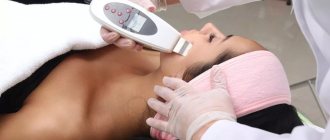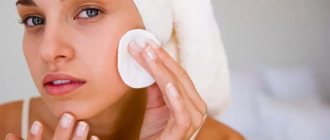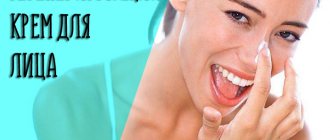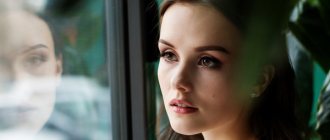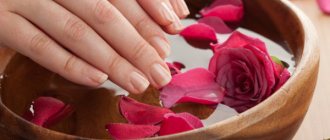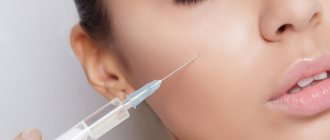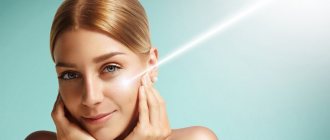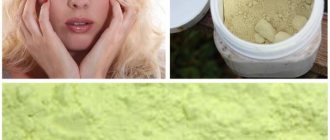Devoid of freckles and pigmentation, white skin is a sign of artistry and attractiveness. For a long time, representatives of the fair sex have tried in a variety of ways to make their skin lighter, using:
- cucumbers;
- curdled milk;
- all kinds of herbal decoctions;
- took sun umbrellas for a walk, etc.
But these times, as they say, have sunk into oblivion, and today, in order to say goodbye to age spots once and for all, ladies use various creams and preparations that may contain substances that are dangerous to the body.
Does hydroquinone help with age spots?
Creams containing the active substance hydroquinone are used for aging skin, for skin with a large number of freckles, acne, discoloration due to melasma and age spots.
Quinol (the old name for hydroquinone) neutralizes tyrosine, which contains copper, through a chemical reaction. It blocks oxidation and prevents metabolic processes from developing - just like vitamin C from a squeezed lemon prevents a cut apple from darkening.
Hydroquinone is very toxic, so its content in cosmetics is minimal (no more than 2%). To avoid allergies, creams containing it must be used very carefully. But even a small amount of cream can have a positive effect on skin affected by age spots. The result makes itself felt within two weeks after using the whitening cream.
Effect on skin
The use of hydroquinone-based formulations is considered very popular because this substance helps whiten the epidermis. The bottom line is that this compound prevents the synthesis of melanin in the skin, and the occurrence of age spots is simply physically impossible. However, creams based on the substance in question are not able to reduce existing pigmentation . It can disappear only after melanin production stops.
The use of hydroquinone cream helps lighten the skin several shades for dark-skinned girls. It is noteworthy that this substance is found in creams, varnishes and dyes for hair and nails, lotions, and a large number of other products for regular use.
Negative sides of hydroquinone
It is recommended to use creams with hydroquinone to get rid of age spots and lighten facial skin for no more than 8 weeks. Creams, with all their advantages, also have negative sides.
- The high levels of carcinogens contained in hydroquinone components make the skin vulnerable to ultraviolet rays, which can lead to skin cancer.
- It is not recommended to use the cream during the daytime, in active sun conditions.
- Collagen destruction leads to rapid skin aging. Therefore, despite all the effectiveness of creams, you should not get too carried away with them.
- It is impossible to get rid of pigmentation forever. Cream with hydroquinone does not destroy stains, but only temporarily blocks the process.
- Abuse (use not according to instructions) of creams with active hydroquinone leads to various skin diseases.
- Cream that gets into the eyes can damage the cornea of the eye. You should use such creams carefully.
Judicious use of creams helps remove age spots, freckles, smoothes wrinkles and brightens the skin.
Table: advantages and disadvantages of using hydroquinone creams
| Advantages | Flaws |
|
|
Achroactive Max cream review
One of the popular creams for getting rid of pigmentation is the cream from the Bulgarian manufacturer Achroactive Max. The cream, the active substance of which is 2% hydroquinone, is considered harmless, but effective for removing age spots, freckles and lightening facial skin.
The low cost of Achroactive Max (from 80 to 190 rubles) with a volume of 45 ml makes it popular.
- An ultraviolet filter protects your facial skin from the harmful effects of the sun.
- Vitamin C protects the skin from aging and reduces pigmentation.
The effect of using Achroactive Max is visible after 2 weeks. The cream is well absorbed, and after a month of use, the face becomes brighter, wrinkles are smoothed out, the skin looks elastic and rejuvenated.
How effective is tretinoin for acne?
Tretinoin is the very first topical retinoid (for external use) that was developed for the treatment of acne and pimples. It is really effective, but under no circumstances, never, ever use it for self-medication. Tretinoin has a large number of side effects - in the form of irritation, dryness, burning, peeling, redness of the skin, which can also result in an increase in the number of pimples and blackheads.
Never use tretinoin products in the following cases:
- if you have dry and/or sensitive skin,
- if you have thin skin,
- if your skin is not prepared for retinoids,
- without consulting a dermatologist.
The fact is that in patients with dry or sensitive skin, the side effects of tretinoin will be much more pronounced than in patients with oily or even normal skin. In addition, tretinoin leads to severe thinning of the stratum corneum of the epidermis. Moreover, this applies even to cream forms that have a minimum concentration of 0.025%. Below we will tell you why everything is so, and which patients we would still be ready to recommend tretinoin for acne and acne.
Clinical Studies - The most famous textbook in dermatology, Fitzpatrick's Dermatology, presents studies on the comparative effectiveness of topical retinoids in the treatment of acne - tretinoin and adapalene. The latter is a topical retinoid already of the 3rd generation. So, clinical trials have shown that drugs with 0.1% adapalene are more or equal in effectiveness - compared to drugs with tretinoin 0.025%. And it was additionally noted that products with adapalene irritate the skin significantly less.
This means that for most patients with acne and pimples there is no point in using products with tretinoin, and products with 0.1% adapalene (preparations Clenzit, Differin, Adaklin and others) will be sufficient for them. According to international treatment protocols, drugs with the topical retinoid adapalene are the first choice drugs for the treatment of acne. Alternative retinoids like tretinoin may only be prescribed in rare cases and will only ever be a 2nd choice drug. Let's see in what cases...
Which patients can we recommend Tretinoin -
There is a small group of patients with acne and pimples in whom the effect of drugs with adapalene 0.1% may not be sufficiently pronounced. In these cases, the lack of effect is primarily associated with insufficient comedolytic action, which means insufficiently active dissolution of the fatty substrate from which comedones are composed (fat plugs in the lumen of the follicles). And for patients in whom the comedolytic effect of drugs with 0.1% adapalene is not sufficiently expressed, we will prescribe them Tretinoin cream or gel.
But even if you are that exceptional patient in whom the comedolytic properties of adapalene turn out to be insufficient, its use will still be effective to some extent. In any case, Adapalene will reduce the activity of the sebaceous glands (reduce oily skin), neutralize the phenomena of follicular hyperkeratosis, and it also has a moderate anti-inflammatory effect (24stoma.ru).
Nevertheless, it should be clearly recognized that drugs with tretinoin (in comparison with adapalene) have slightly more pronounced comedonolytic and anti-inflammatory properties. But on the other hand, preparations with tretinoin are not photostable (they are destroyed when exposed to light), they irritate the skin much more and can even lead to burns, urticaria and severe hyperpigmentation. Cream forms cause fewer side effects than gel tretinoin, i.e. if you take cream and gel of equal concentration, then the gel will always be a priori stronger.
Our recommendation - we already wrote above that there is such a drug as “Retin A Micro” - in the form of 0.04% or 0.1% gel. It differs from all other tretinoin gel preparations in that the tretinoin molecules in it are enclosed in special microspheres (microcapsules). Microcapsules dissolve at different rates, which allows trans-retinoic acid molecules to be released not immediately, but gradually. This allows you to reduce the degree of skin irritation without reducing the effectiveness of the drug).
Tretinoin for acne: before and after photos
How to apply the drug correctly. What course of treatment?
The cream is applied once a day (at night), but for the first 2 weeks we recommend that you use the drug only 3 times a week so that the skin gets used to the effects of such a strong retinoid. The drug is applied to the surface of the facial skin, cleaned with mild detergents and well dried. The cream is applied in a thin layer using your fingers, but only on those areas of the facial skin that have acne elements (comedones, papules or pustules).
For 1 application, a large pea-sized amount of cream is usually sufficient. The first visible result will be noticeable no earlier than 4 weeks from the start of therapy. A satisfactory result will appear no earlier than after 8-12 weeks. The full course of treatment is at least 3 months. It is worth considering that if tretinoin is used for papulopustular acne (pimples), then it is absolutely normal that in the first 2 weeks you will first notice a deterioration in the condition of your facial skin. In this case, there is no need to discontinue the drug.
Important points - in this case, more does not mean better. It is advisable to start using only 0.025% concentration of tretinoin in the form of a cream (in the form of a gel - only if you have oily and thick skin). An exception would be the drug “Retin A Micro” - you can start using it with a 0.04% concentration, because tretinoin is contained in microcapsules. Higher concentrations will definitely cause significant redness and flaking of the facial skin.
In addition, it is very important that in parallel you use sunscreen with SPF 50 (in spring and summer), as well as moisturizers to prevent dryness and irritation of the skin. All products must be non-comedogenic! Using greasy products that clog your pores will only worsen your acne and pimples.
Features of tretinoin therapy for acne and pimples -
Everything is clear with the treatment of acne - monotherapy with tretinoin is used here. But with the papulopustular form of acne (pimples), a drug with tretinoin alone is not enough, and here you have to additionally add drugs with antibiotics and/or a bactericidal component such as benzoyl peroxide. And this is where many problems with drug combinations begin.
For example, there are combination drugs where the topical retinoid adapalene 0.1% is combined with either the antibiotic clindamycin or benzoyl peroxide (these are the drugs Klenzit-S and Effezel, respectively). In addition, monopreparations with 0.1% adapalene (Klenzit, Differin) can be easily combined with monopreparations based on benzoyl peroxide (Baziron AS), dividing their use in the morning/evening. But drugs with tretinoin are not combined with anything other than antibiotics. The fact is that benzoyl peroxide has its own pronounced irritant effect on the skin, and it cannot be used together with tretinoin.
Using antibiotics topically or orally (without drugs with benzoyl peroxide) is also bad, because this contributes to the development of antibiotic resistance in P. acnes bacteria. Overall, this is a very complex topic, and if you are interested in international protocols for the treatment of acne and pimples, you will find them at the following links:
→ Protocols for the treatment of acne (comedones) → International protocols for the treatment of acne
Achromin cream review
Bulgarian cream Achromin belongs to the budget creams from the series of whitening products.
Achromin is able to get rid of freckles, acne, and age spots within 2-3 weeks. Helps cope with the consequences of skin diseases, such as post-acne. Lactic acid helps increase the flow of vitamins to the epidermis, which speeds up the healing process of the skin after illness. The complex effect of hydroquinone with other components makes the skin bright, clean and toned. The face looks healthier and younger.
Compound
The cream contains hydroquinone - 2%, licorice root juice, lanolin, lactic acid, glycerin, substances with a UV filter, rose fragrance.
The cost is no more than 100 rubles for a volume of 65 ml.
Basic properties
Whitening creams with hydroquinone initially delight with their effect. This substance is an organic compound that is a strong antioxidant, reagent and reducing agent. The percentage of its content in cosmetic products varies from 2 to 4%.
Hydroquinone blocks melanin production by reducing metabolic processes. It neutralizes the tyrosine so the area can no longer oxidize and therefore no discoloration occurs. The effect of using the cream begins to appear after a couple of weeks.
It is important to note that over time, the skin begins to get used to the toxic effects of the substance and stops reacting. Therefore, we have to use more aggressive means.
Expert opinion
Tatyana Somoilova
Cosmetology expert
Hydroquinone turns into a poison when exposed to sunlight. This provokes the development of cancerous formations on the skin. Therefore, it is prohibited to use the cream during the daytime.
Astramin cream review
Astramin cream has undergone clinical trials and has been found safe for use. The main feature of Astramin is its effectiveness: the cream is able to combat skin problems within a month from the date of last use.
- Eliminates freckles and pigment spots.
- Eliminates age-related darkening of facial skin.
- Protects against pigments - lentigo.
- Protects against ultraviolet radiation.
- Cleanses dead skin cells of the dermis.
- Whitens the face after sunbathing.
Astramin cream (priced from 120 rubles per 45 ml.) is quite effective. It can be used for up to 2 months without harm to the skin. The effect is visible already on day 5.
Compound
Contains fruit and lactic acids, UV filter substances, vitamin C.
120 rubles for 45 ml
Tretinoin cream: instructions for use
If you use tretinoin anti-wrinkle cream on your own, reviews clearly indicate a high frequency of side effects as a result of self-medication. It is advisable to consult a dermatologist before using the drug, so that the doctor can determine your skin type and how suitable this drug is for you. For example, it is recommended to use tretinoin for wrinkles only 2 times a week for the first week, and 3 times a week for the second week (this will allow the skin to get used to the effects of tretinoin).
For the next 2 weeks you can use the drug every other day, and then start using it every day. Each time before applying the cream, you should thoroughly wash your skin with a mild cleanser and dry it. Before applying the cream, you need to ensure that it dries completely, because... When applying the cream to insufficiently dry skin, you will instantly get severe irritation.
It is best to apply tretinoin anti-wrinkle cream before bed, at approximately the same time every day. A pea-sized amount of cream should be enough for all areas of the face. Gently rub Tretinoin cream into the skin of the face and neck, avoiding contact with the mucous membranes of the eyes, lips and nose or damaged skin. You should not apply the cream to the skin adjacent to the wings of the nose. When using tretinoin during periods of high solar activity, always use sunscreen with SPF 50, because otherwise you will get severe skin pigmentation.
When will you be able to see the results? What is the course of treatment?
If we are talking about acne treatment, then you will be able to see the very first visible result no earlier than after 4-6 weeks of therapy. A good result will be visible after the full course of treatment, which, depending on the type of acne, can last from 3 to 6 months. If we are talking about skin rejuvenation, the duration of the course will directly depend on the age and condition of the skin. It makes no sense to use the drug for less than 3-4 months (this period is sufficient if retinoids are used only as a step before hardware methods - fractional RF lifting or fractional laser).
In order to achieve a significant improvement in skin condition, the course must be at least 1 year. In this case, you can really notice a decrease in the depth of wrinkles and fine lines, and an increase in skin elasticity. After completing the course, it will be necessary to switch to maintenance therapy with milder types of topical retinoids, for example, this could be anti-aging cosmetics with pure retinol at least 0.3-0.4% concentration (we are talking about pure retinol, not retinol esters) .
Expigment cream review
Sold in two versions with hydroquinone content 2% and 4%. If you use the second option, the effect will be more obvious. But it is not recommended to use it for a long time. It is not recommended to use 4% cream for more than 1 month due to increased toxicity.
Compound
In addition to hydroquinone, it includes fruit acids, lactic acids, and ascorbic acid (vitamin C).
Turkish whitening cream Expigment can be bought at a pharmacy for 800 rubles per 30 g.
Contraindications and side effects –
Pregnant and breastfeeding women should definitely consult a doctor before using products containing tretinoin - reviews from dermatologists tirelessly repeat this. Because these drugs are absorbed through the skin and may cause potential harm. But it is best to completely avoid using this group of drugs during pregnancy and lactation.
The most common side effects are
- itching, burning, skin irritation,
- the appearance of dryness, peeling (Fig. 16),
- redness (Fig. 17),
- skin pigmentation,
- sensation of warmth, tingling at the site of application of the drug.
Less common side effects:
- hives,
- burns,
- difficulty breathing.
To reduce side effects, it is recommended to use skin moisturizers 2 times a day (morning and evening). In the evening, moisturizer can be applied approximately 30 minutes after using tretinoin. But it should be taken into account that in addition to tretinoin, today there are other products with retinoids that are much safer and no less effective.
